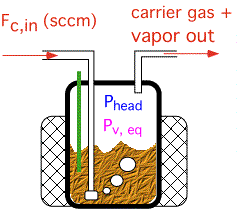Special Topic: Vapor Delivery
Many precursors are liquid at room temperature and even at convenient elevated temperatures. If the vapor pressure is less than the chamber operating pressure, we cannot deliver the vapor to the chamber using conventional gas handling. Something else is needed...
Option 1: Double, double, toil and trouble...
A common solution to this problem is to use a bubbler to deliver the vapor. A bubbler is a sealed container containing the liquid whose vapor is to be delivered, with (at least) two tubes inserted. One tube penetrates below the level of the liquid and delivers a (typically inert) carrier gas. The other tube extracts a carrier/vapor mixture from the "headspace" above the liquid. Bubblers are simple to construct and operate (and thus inexpensive), and are very precise and reliable when properly used.

Bubblers depend on the formation of small bubbles of carrier gas in the liquid, in which the vapor quickly attains its equilibrium vapor pressure as the bubbles float to the liquid surface. A "sparger" (a cap with multiple small perforations) is sometimes added to the end of the dip tube to ensure formation of small bubbles and rapid equilibration. It should be apparent that the operation of the bubbler is dependent on the liquid level. In bubblers made of quartz or glass simple visual observation suffices to establish the liquid level, but in bubblers made of stainless steel (often used for safety) a level sensor is helpful. The level sensor is often simply a quartz tube with an angle-cut end. When the tube is immersed in a liquid with refractive index close to that of the quartz, little light is reflected from the tube end. Once the liquid falls below the end of the tube, light is reflected from the exposed end. A simple light and photosensor at the external end of the level sense tube thus enables automated monitoring of the level, sometimes used to control automated refilling of the bubbler.
The amount of vapor delivered is determined by the vapor pressure and thus the temperature of the liquid. Temperature control is indispensable for accurate vapor delivery even when the nominal liquid temperature is set at room temperature.
...carrier flow and precursor bubble!
Return to Tutorial Table of Contents
Book version of the CVD Tutorial
